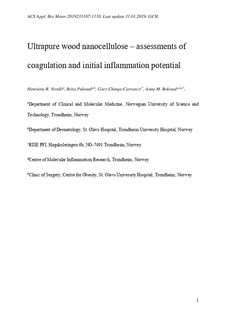| dc.contributor.author | Nordli, Henriette R. | |
| dc.contributor.author | Pukstad, Brita | |
| dc.contributor.author | Chinga-Carrasco, Gary | |
| dc.contributor.author | Rokstad, Anne Mari | |
| dc.date.accessioned | 2019-11-06T07:58:05Z | |
| dc.date.available | 2019-11-06T07:58:05Z | |
| dc.date.created | 2019-02-12T10:47:22Z | |
| dc.date.issued | 2019 | |
| dc.identifier.citation | ACS Applied Bio Materials. 2019, . | nb_NO |
| dc.identifier.issn | 2576-6422 | |
| dc.identifier.uri | http://hdl.handle.net/11250/2626780 | |
| dc.description.abstract | Using a lepirudin-based human whole blood model, we evaluated the initial inflammatory and coagulation responses of dense and porous ultrapure (<50 endotoxin units/grams) cellulose nanofibrils (CNF), of carboxylated grade. The CNF was compared to the wound dressing AquaCel because it is a potential wound-healing material. The porous CNF aerogels induced the strongest coagulation potential measured as prothrombin factor 1.2 (PTF1.2). AquaCel induced the strongest complement response by terminal complement complex (TCC) and surface C3c. All materials activated leukocytes CD11b, while the levels of only 3 of 27 cytokines were significantly changed, limited to (i) an elevation of the monocyte chemoattractant protein-1 (MCP-1/CCL) by the CNF aerogel, (ii) a reduction of eosinophil chemotactic proteins (eotaxin/CCL11) by the CNF aerogel, and (iii) a reduction of platelet-derived growth factor BB (PDGF-BB) by all CNF materials. In conclusion, the CNF materials and AquaCel differently activate coagulation, complement, and cytokines, improving the selection possibilities in various treatment situations of wound healing. | nb_NO |
| dc.language.iso | eng | nb_NO |
| dc.publisher | American Chemical Society | nb_NO |
| dc.title | Ultrapure Wood Nanocellulose - Assessments of Coagulation and Initial Inflammation Potential | nb_NO |
| dc.type | Journal article | nb_NO |
| dc.type | Peer reviewed | nb_NO |
| dc.description.version | acceptedVersion | nb_NO |
| dc.source.pagenumber | 12 | nb_NO |
| dc.source.journal | ACS Applied Bio Materials | nb_NO |
| dc.identifier.doi | 10.1021/acsabm.8b00711 | |
| dc.identifier.cristin | 1676290 | |
| dc.relation.project | Samarbeidsorganet mellom Helse Midt-Norge og NTNU: 46056819 | nb_NO |
| dc.relation.project | Norges forskningsråd: 219733 | nb_NO |
| dc.relation.project | Norges forskningsråd: 223255 | nb_NO |
| dc.description.localcode | Locked until 31.1.2020 due to copyright restrictions. This document is the Accepted Manuscript version of a Published Work that appeared in final form in [ACS Applied Bio Materials], copyright © American Chemical Society after peer review and technical editing by the publisher. To access the final edited and published work see https://doi.org/10.1021/acsabm.8b00711 | nb_NO |
| cristin.unitcode | 194,65,15,0 | |
| cristin.unitcode | 1920,0,0,0 | |
| cristin.unitname | Institutt for klinisk og molekylær medisin | |
| cristin.unitname | St. Olavs Hospital HF | |
| cristin.ispublished | false | |
| cristin.fulltext | original | |
